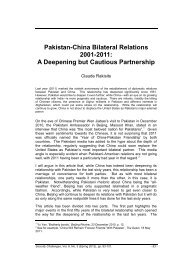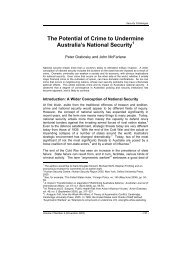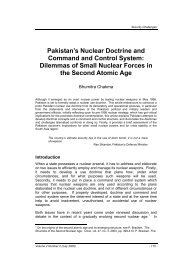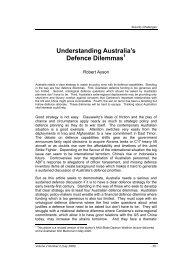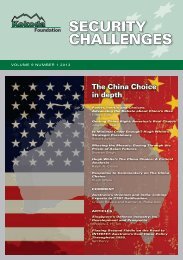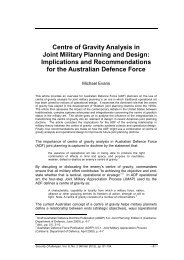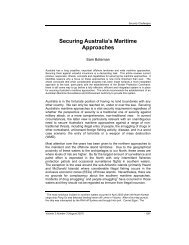The Transformation of Triad - Security Challenges
The Transformation of Triad - Security Challenges
The Transformation of Triad - Security Challenges
Create successful ePaper yourself
Turn your PDF publications into a flip-book with our unique Google optimized e-Paper software.
Roderic Broadhurst and Lee King Wa<br />
importance <strong>of</strong> ‘guan xi’ (interpersonal reciprocity) in establishing trustworthy<br />
networks has been noted 77 but is a general trait among Chinese and not<br />
particular to triad societies. 78 This mode <strong>of</strong> exchange based on personal<br />
obligation is structured by patron-client relationships among triads where the<br />
dai lo (big brother) is the central focal point <strong>of</strong> the ‘cell’ in (networked)<br />
personal relationships. 79 In a largely immigrant society, such as Hong Kong<br />
was throughout the last century, the triad once represented a vital form <strong>of</strong><br />
social capital in lieu <strong>of</strong> the family and clan. 80 <strong>Triad</strong> membership <strong>of</strong>fered<br />
protection for otherwise vulnerable individuals exposed to unemployment<br />
and social exclusion. 81 Such changes have led some to argue that although<br />
‘old’ triads may have transformed into the ‘dark societies’ <strong>of</strong> the ‘Chinese<br />
underworld’, their history and social capital made them influential role<br />
models for later groups. 82<br />
SCALE AND ACTIVITIES<br />
Despite lurid media depictions and periodic alarm over their influence, triad<br />
involvement in recorded crime in HK has remained static at around three to<br />
four per cent <strong>of</strong> all police-recorded crime for the past twenty years. In 2006<br />
triad-related crime represented three percent <strong>of</strong> all reported crime (2359 <strong>of</strong><br />
81,225) but in the context <strong>of</strong> an overall decline in recorded crime. 83 In 2006<br />
most recorded triad-related crime were ‘unlawful society’ or triad<br />
membership <strong>of</strong>fences (806 cases or 33.6 percent), wounding and serious<br />
assault (616 cases or 25.1 percent), serious narcotics <strong>of</strong>fences (78 cases or<br />
3.3 percent) and blackmail/extortion (226 cases or 9.4 percent). 84<br />
In HK, triad society has long been regarded as “simply a criminal conspiracy<br />
that has been given statutory recognition” (see R v Sit Yat-keung 1985 85 ). In<br />
77 Williams and Godson, ‘Anticipating Organised and Transnational Crime’; Chung, ‘<strong>The</strong> Big<br />
Circle Boys: Revisiting the Case <strong>of</strong> the Flaming Eagles’; McIllwain, ‘Organized Crime: A Social<br />
Network Approach’; Meyers III, ‘<strong>The</strong> Emerging Threat <strong>of</strong> Transnational Organized Crime from<br />
the East’.<br />
78 See generally X. T. Fei, From the Soil: <strong>The</strong> Foundations <strong>of</strong> Chinese Society (University <strong>of</strong><br />
Berkeley: University <strong>of</strong> California Press, 1992) (translated G. Hamilton and W. Zheng).<br />
79 H. B. Milward and J. Raab, ‘Dark Networks as Organizational Problems: Elements <strong>of</strong> a<br />
<strong>The</strong>ory’, International Public Management, vol. 9, no. 3 (2006), pp. 333-60.<br />
80 R. E. Mitchell, Velvet Colonialism’s Legacy to Hong Kong 1967 and 1997, Hong Kong Institute<br />
<strong>of</strong> Asia-Pacific Studies, Occasional Paper No. 76 (Shatin Hong Kong: Chinese University <strong>of</strong><br />
Hong Kong, March 1998).<br />
81 Chu, <strong>The</strong> <strong>Triad</strong>s as Business.<br />
82 Arsovska and Craig, ‘Violence in Ethnic-Based Organised Crime Groups’; Yu, <strong>The</strong> Structure<br />
and Subculture <strong>of</strong> <strong>Triad</strong> Societies in Hong Kong.<br />
83 R. G. Broadhurst, K. W. Lee and C. Y. Chan, ‘Crime trends in Hong Kong’, in T. W. Lo and W.<br />
H. Chu (eds), Crime and Criminal Justice in Hong Kong (Devon: Willan, 2008), pp. 45-68.<br />
84 In 2007 the number <strong>of</strong> triad-related cased continued to decline (2259 cases or 2.8 percent <strong>of</strong><br />
all crimes in 2007) but a 5.7 percent increase in triad-related reports was recorded for 2008, see<br />
[Accessed 11 May<br />
2009]. For a summary <strong>of</strong> recent trends see: HKSAR Fight Crime Committee Annual Reports<br />
2003-2007, [Accessed 9 March and 11 May 2009].<br />
85 See R v Sit Yat-keung, HK Magistracy Appeal no. 783, 1986: in this case and others,<br />
problems arising from admissions to police and what constitutes expertise about triad culture<br />
- 12 - <strong>Security</strong> <strong>Challenges</strong>



